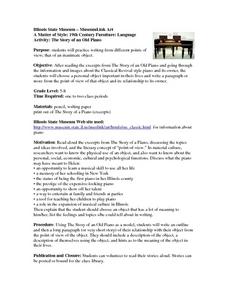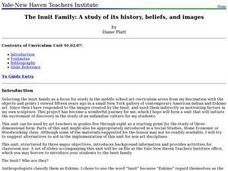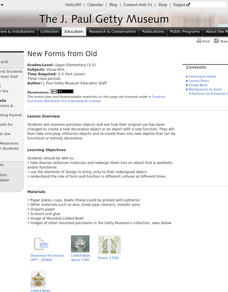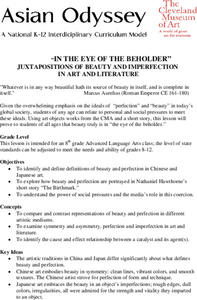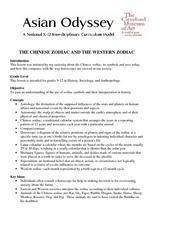Curated OER
"For The Birds" [part II]
Pupils examine how Chinese and Japanese artists used different kinds of birds
as representations of ideas that were important in both cultures and create their own birds using the technique of origami.
Curated OER
Italy: Festa del Grillo
Young scholars examine the traditions of the Festa del Grillo in Italy and its relationship to the culture of Italy. After being shown examples, they create their own cricket out of materials found in the classroom. Using 3D, they...
Curated OER
Visual Arts Lesson -Wardrobe
Young scholars define the term neoclassism and locate examples of it in furniture design. They research and explain the role of the wardrobe in viceregal Mexico. Pupils compare and contrast the use of wardrobes as storage in the earlier...
Curated OER
Ceramics: A Vessel into History
Students create a ceramic vessel, discuss their artistic choices, and identify elements derived from historical examples. In this ceramics lesson, students identify symbols and imagery that are connected to a specific...
Curated OER
Egyptian Tomb Art: Expressions of Religious Beliefs
Ninth graders are introduced to the Prown's technique of describing various objects. As a class, they view pictures of the pyramids in Egypt and discuss how the size and shape of them show their belief in eternal life and religion. ...
Curated OER
The Story of an Old Piano
Students read excerpts from The Story of an Old Piano. They choose a personal object and write paragraphs from the object's point of view. Their stories can be bound for the class library.
Curated OER
The Family: Louisiana Family Folklore
Students explore and identify family treasures and research the history to each one. They also organize a variety of artifacts into various categories and research traditional Louisiana artifacts online. Each student draws inferences...
Curated OER
Southeastern Native Americans' Lifestyles
Students complete activities to learn about Southeastern Native Americans. In this lifestyles lesson, students watch a PowerPoint about Southeastern Native Americans, view artifacts from the region and discuss the objects with a...
Curated OER
Still Life
Young scholars investigate still-life drawings. In this visual arts lesson, students draw each other pretending to be frozen making sure that they do not simply see the object as the object, but seeing the...
Curated OER
Identity Boxes
Students create a "portrait" box that contains symbolic representations of their own identity. In this Lucas Samaras and Joseph Cornell art lesson, students discover ways that these two artists used symbols and objects to represent...
Curated OER
Sticks, Stones, Sinews and Stuff: How Early People Used the Environment to Meet Basic Needs
Students create an artifact. In this early survival lesson, students use found objects to create an artifact that could have been used to help early people meet their basic needs.
Curated OER
Paper Towers
Young scholars have the opportunity to use model-building as a way to help comprehend the forces and phenomena at work in the world around them. They describe gravity as a universal force that pulls everything toward the center of the...
Curated OER
Families
First graders complete a unit on families and family structures. They create a family tree for their own family, construct a family mobile, sort and discuss photos of families from around the world, create a banner of ways to say "I...
Curated OER
Portrait of the Artist - Georgia O'Keeffe
Students study the work of Georgia O'Keefe. They use a digital camera or scanned images from a regular camera and the PhotoShop application to create a landscape of their own which reflects the important shapes or objects in their...
Curated OER
Expressive Hands with Stippling Value Shading
Students create a larger than life modified contour drawing of hands in an expressive situation. Hands have linear value, contain a object, and have a patterned background.
Curated OER
The Inuit Family: A study of its history, beliefs, and images
Learners study the Inuit in terms of their geographic location and its influence on their way of life. They investigate Inuit imagery as a reflection of their belief system and focus on the objects of the Inuit to introduce...
Curated OER
Why is this lesson constructivist?
Students formulate a definition of tessellations by comparing and contrasting different patterns and shapes of real objects. They discuss the relatioship between shapes and patterns as well as their function in the real world. Students...
Curated OER
Roman Numerals and Their History
Students identify Roman numerals and the history associated with them. In this historical number lesson, students investigate charts and photographs to discover the history of Roman numerals. Students bring a Roman numeral...
Curated OER
New Forms From Old
Students examine porcelain objects and observe how their original use has been changed to decorative objects. They choose everyday objects and re-create them into new objects that can be functional or entirely decorative.
Curated OER
Alaskan Eskimo Collection
Students analyze mystery photographs to determine key characteristics about the Alaskan environment and Eskimo culture. In this Eskimo activity, students read an Eskimo folktale and write their own in response. Lastly students complete a...
Curated OER
In The Eye Of The Beholder
Students identify and define definitions of beauty and perfection in Chinese and
Japanese art and compare those definitions to other cultural beliefs and societies. This lesson includes a two-part lesson evaluation.
Curated OER
Chinese Ritual: The Death Ceremony
Students discuss the importance of the Death Ceremony in Chinese culture using Du Fu's poem "Fireflies" as a basis of information and create original poetry in the style of Poet Du Fu.
Curated OER
The Chinese Zodiac And The Western Zodiac
Students create individual horoscopes that contrast and compare Western and
Chinese views of their futures using poster boards and magic markers. In-class discussion is used to evaluate the use of the Zodiac in different cultures.
Curated OER
Deerfield Debates Its Future: The Colonial Revival
Students analyze why the Colonial Revival came as a response to cultural changes caused by technological development, industrial growth, and changing populations in Deerfield and the Connecticut River Valley.
!["For The Birds" [part II] Lesson Plan "For The Birds" [part II] Lesson Plan](http://content.lessonplanet.com/resources/thumbnails/122476/large/cgrmlwnvbnzlcnqymdeymtaxny0yoda5lwu0ew85zi5qcgc.jpg?1414222640)




